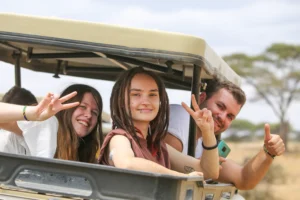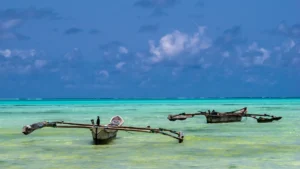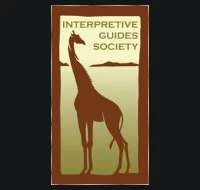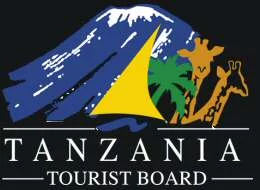As we know, every successful climber relies on essential gear. Here’s Benson Safaris complete guide of things to carry as you gear up for Kilimanjaro: Your Essential Mount Kilimanjaro Packing List.
Mount Kilimanjaro, nestled in Tanzania’s Kilimanjaro region, reigns as Africa’s highest peak and the world’s second-highest freestanding mountain. Its majestic allure, diverse landscapes, and accessible routes make it a favorite among adventurers seeking a thrilling and rewarding climb.
Things to keep in mind when planning for Mount Kilimanjaro packing list
When preparing for a climb up Mount Kilimanjaro, it’s essential to carefully consider your packing list to ensure a successful and comfortable journey. Here are some key factors to keep in mind while compiling your Kilimanjaro packing list.
Quick Change of Weather
Mount Kilimanjaro is known for its rapidly changing weather conditions. As you ascend, temperatures can vary drastically, from warm tropical weather at the base to below freezing temperatures at the summit. Packing layers that can be easily added or removed is crucial. Include breathable, moisture-wicking base layers, insulating mid-layers, and a waterproof and windproof outer layer.
Weight vs. Comfort
Balancing the weight of your pack with the necessity for comfort is vital. Every extra pound can make the trek more challenging, so it’s important to pack efficiently. Choose lightweight, multi-functional gear and clothing that can serve multiple purposes. For instance, a lightweight jacket that is both insulating and water-resistant can eliminate the need for separate items.
Optimizing Weight Distribution for Comfortable Trekking
Ensuring proper weight distribution in your backpack is crucial for a comfortable and safe trek, especially on a multiday adventure like the Mount Kilimanjaro climb. Here’s how you can optimize weight distribution.
- Heavier Items at the Bottom: Place heavier items, such as your sleeping bag, tent, and cooking equipment, closer to your back and at the bottom of your backpack. This lowers your center of gravity, providing better stability and balance while walking.
- Medium-weight Items in the Middle: Pack medium-weight items, like clothing layers and food, in the middle section of your backpack. This helps distribute weight evenly across your back and prevents the pack from feeling lopsided.
- Lighter Items on Top: Reserve the top portion of your backpack for lighter items such as rain gear, extra layers, and snacks. Placing them on top keeps them easily accessible without compromising weight distribution.
- Balancing Side-to-Side: Ensure that weight is evenly distributed from side to side within your backpack. This prevents the pack from pulling to one side and causing discomfort or strain while hiking.
- Use Compression Straps: Utilize compression straps on your backpack to cinch down and secure items, minimizing shifting during movement. This helps maintain stability and balance, especially when navigating uneven terrain.
- Regularly Adjust and Check: Periodically adjust the contents of your backpack while on the trail to maintain optimal weight distribution. This ensures ongoing comfort and reduces the risk of fatigue or injury from imbalanced loads.

Functionality of Clothing
The functionality of your clothing is paramount on Kilimanjaro. Opt for synthetic or wool fabrics over cotton, as cotton absorbs moisture and dries slowly, which can lead to discomfort and even hypothermia in colder conditions. Synthetic materials, on the other hand, provide better insulation and dry quickly. Also, ensure that your clothing allows for full mobility and comfort over long trekking days.
Choosing the Right Fabrics
The choice of fabric is critical in the varying climates of Kilimanjaro. Avoid cotton and opt for layers made from merino wool or synthetic fibers, which maintain insulation when wet and manage sweat more effectively. Quick-drying and UV-protective fabrics can be particularly useful during the day when the sun is strong, and temperatures might be higher.
Layering
Layering in mountain climbing involves wearing multiple clothing layers, each with a specific function, to manage body temperature and moisture effectively. More explained below.
The difficulty of climbing Mount Kilimanjaro should not deter you; it should inspire you. With the right preparation, mindset, and support from Benson Safaris, reaching the summit is an achievable dream. Read the article on Kilimanjaro Climb.
Layering Strategy for Mount Kilimanjaro Packing List
This approach offers several advantages. Firstly, it allows climbers to adapt to changing Mount Kilimanjaro weather conditions by adding or removing layers as needed, ensuring optimal comfort and performance throughout the climb. For example, climbers can easily shed a jacket when it’s warm and put it back on when temperatures drop, maintaining comfort and preventing overheating or chilling. Additionally, layering provides versatility and flexibility, enabling climbers to stay prepared for various weather scenarios encountered during their ascent. Overall, layering is a fundamental strategy in mountain climbing, offering climbers the ability to regulate their body temperature and manage moisture efficiently in diverse environmental conditions. Below is layering breakdown to help while planning your Kilimanjaro climb packing list.
Base Layers: Stay Dry and Comfortable
When preparing for your climb up Mount Kilimanjaro, prioritize your base layers for optimal comfort and performance. Choose moisture-wicking fabrics like polyester or merino wool to keep your skin dry and regulate temperature. Ensure your underwear and sports bra are airy and breathable for added comfort during the journey. Don’t forget to include a lightweight T-shirt or long-underwear top, paired with long-underwear bottoms, to provide warmth and flexibility. Complete your base layer ensemble with wool or synthetic socks for dry, comfortable feet on the trail.
Mid Layers: Providing Warmth and Flexibility
As you ascend Kilimanjaro, mid layers become essential for maintaining warmth and flexibility. Pack a fleece jacket or soft-shell jacket for breaks or early morning starts, offering insulation without adding bulk to your pack. Opt for durable and wind-resistant soft-shell climbing pants to ensure comfort throughout your climb. Remember to bring along essential accessories such as a sun hat and liner gloves for added protection and warmth when needed.

Insulation Layers: Bracing Against Cold
Prepare for colder conditions on your Kilimanjaro climb with insulation layers like an insulated jacket and pants. Keep these items easily accessible in your pack for quick layering during breaks or chilly weather. Select lightweight and packable options to provide efficient insulation without weighing you down. Enhance your cold weather protection with glacier glasses and midweight gloves, offering further defense against low temperatures and wind.
Outer Layers: Defending Against the Elements
Equip yourself with waterproof outer layers—a jacket and pants—to defend against the elements encountered on Mount Kilimanjaro. These essential layers provide crucial protection against rain, snow, and wind, ensuring you stay dry and comfortable in changing weather conditions. Consider bringing along ski goggles, neck gaiters, and insulated mittens for additional warmth and protection when facing harsh weather conditions.
Sleeping Gear Plan for Kilimanjaro Packing List
Ensuring a good night’s sleep is essential for rejuvenation during your Kilimanjaro climb. Include the following items in your Kilimanjaro climb packing list to ensure a comfortable rest at camp:
Sleeping Bag: Cozy Nights Under the Stars
Select a high-quality sleeping bag rated for cold temperatures to keep you warm throughout the night. Look for lightweight and compressible options to minimize pack weight and space. Consider the expected temperatures on your climb when choosing the appropriate warmth rating for your sleeping bag.
Sleeping Pad: Cushioned Support for Restful Sleep
Pack a durable sleeping pad to provide cushioned support and insulation from the cold ground. Opt for an inflatable or foam pad that offers comfort and warmth without adding excessive weight to your pack. A comfortable sleeping pad is essential for ensuring a restful night’s sleep at high altitudes.
Pillow: Adding Comfort to Your Campsite
While not essential, bringing a small inflatable pillow can significantly enhance your sleeping comfort at camp. Look for a compact and lightweight pillow that can be easily inflated and deflated for convenient storage in your pack. Resting your head on a pillow after a long day of hiking can make all the difference in ensuring a restorative night’s sleep.
Sleepwear: Cozy Apparel for Relaxation
Include comfortable sleepwear in your Mt Kilimanjaro packing list to ensure maximum relaxation during downtime at camp. Choose lightweight and breathable pajamas or loungewear that provide warmth without overheating. Opt for moisture-wicking fabrics to keep you dry and comfortable throughout the night.
Shelter: Protection from the Elements
Ensure you have adequate shelter to protect you from the elements while sleeping at camp. Whether you choose to bring a tent, bivy sack, or tarp, ensure it provides sufficient protection from rain, wind, and cold temperatures. Consider the weight and size of your shelter option when planning your Mt Kilimanjaro packing list to minimize bulk and maximize comfort during your climb.

Backpack Choice for Kilimanjaro Packing List
For a multiday adventure like the Mount Kilimanjaro trek, a well-suited backpack is essential. Look for a pack with ample capacity to accommodate all your gear from the Kilimanjaro packing list, ensuring you have everything you need for the journey. Comfortable straps and back support are crucial for long hours of trekking, minimizing strain and discomfort along the way.
Considering whether to rent or buy climbing gear for your Kilimanjaro trek? Renting in Arusha is a convenient and cost-effective option, especially for first-time climbers or those who don’t frequently tackle high-altitude treks. It allows you to use high-quality equipment without the need to purchase and transport your own gear to Tanzania.
Navigation Tools: Mt Kilimanjaro Packing List
Navigation tools are essential for navigating the diverse terrain of the Mount Kilimanjaro trek. Make sure your Kilimanjaro climb packing list includes essentials like maps, compasses, and GPS devices. If you lack these tools, don’t worry—our experienced guides at Benson Safaris Tanzania are well-versed in the routes, providing expert guidance throughout your journey on Mount Kilimanjaro.
Safety Equipment Plan for Kilimanjaro Climb Packing List
Safety equipment is paramount for any Kilimanjaro packing list, ensuring a secure trek up Mount Kilimanjaro. Headlamps provide vital illumination during early morning starts or late-night treks, while first aid kits offer essential medical supplies for emergencies. Additionally, emergency communication devices, such as satellite phones or personal locator beacons, ensure connectivity even in remote areas. At Benson Safaris Tanzania, safety is our priority, and our guides are trained to handle any situation, providing peace of mind throughout your journey.

Food and Hydration Plan for Mount Kilimanjaro Packing List
When preparing your essentials for the Kilimanjaro climb packing list, don’t overlook the importance of food and hydration. Pack lightweight, high-energy snacks to keep you fueled throughout the trek. Ensure you have an ample water supply or a hydration system to stay hydrated during your journey with Benson Safaris Tanzania.
Protection from Elements
Ensure you’re prepared for elements like sun exposure by packing sunglasses, sunscreen, lip balm, and hats. These essentials safeguard you from harmful UV rays and maintain hydration, crucial for your Kilimanjaro climb packing list.

Miscellaneous Items to Consider when planning for Kilimanjaro Packing List
Don’t forget miscellaneous items like trekking poles, multi-tools, camera gear, and personal hygiene products to enhance your trekking experience on Mt. Kilimanjaro.
Expert Tips for Your Kilimanjaro Packing List
When preparing for your trek up Mount Kilimanjaro, start with a comprehensive checklist to ensure no essential gear is overlooked. Opt for high-quality, multi-use items that offer both durability and functionality, reducing the overall weight of your pack. Before your climb, test all gear on shorter hikes to ensure comfort and effectiveness. On the trek, prioritize hydration by using a bladder for easy access to water, and pack energy-rich snacks like nuts and dried fruits to maintain energy levels. Consider renting heavier items locally to save on travel costs and pack extra batteries or a power bank to keep electronic devices charged. Remember, maintaining the cleanliness of the mountain is crucial, so carry small bags for your trash, ensuring a responsible climb.
Get more information on Mount Kilimanjaro, how to get there, climate zone, trekking routes and more on our Kilimanjaro Climbing Guide.
Explore Mount Kilimanjaro’s diverse trekking routes, each offering unique landscapes, challenges, and opportunities for unforgettable adventures at Africa’s highest peak. Read More
Frequently Asked Questions About Mt Kilimanjaro Packing List
Ensure you pack layers for changing weather, including moisture-wicking base layers, insulating mid-layers, a waterproof jacket, and pants. Also include a sleeping bag suitable for low temperatures, a comfortable backpack, and hiking boots.
Yes, you can rent high-quality climbing gear in Arusha. This includes items like sleeping bags, boots, and insulated jackets, which are available at local rental shops.
Choose sturdy, waterproof hiking boots with good ankle support. It’s crucial to break them in well before your trek to avoid blisters.
Pack high-energy, lightweight snacks such as nuts, dried fruits, and energy bars. Water purification tablets or a water filter system is essential for ensuring safe drinking water.
Carry a basic first aid kit, altitude sickness medication as recommended by your doctor, sunscreen, and insect repellent. Make sure to discuss any health concerns with your guide.
Weather on Kilimanjaro can vary dramatically, from tropical heat at the base to below-freezing temperatures at the summit. Packing for all conditions is imperative.
Layering is key. Have layers that can be easily added or removed as you ascend through different climate zones, from rainforests to alpine deserts to arctic conditions at the summit.
Yes, climbers are typically allowed a personal luggage limit of 15 kg (33 lbs), which porters will carry. It’s important to pack efficiently and only bring essentials.
A comfortable, day-size backpack (20-35 liters) is ideal for carrying your daily essentials like snacks, water, camera, and extra clothing.
Yes, trekking poles are highly recommended for Kilimanjaro. They can reduce the impact on your knees and help with balance and stability, especially during descents.
Read our reviews on TripAdvisor and Safari Booking







